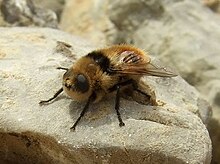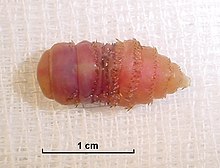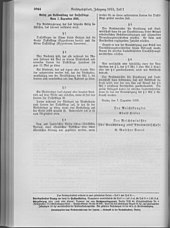Botflies
| Botflies | ||||||||||||
|---|---|---|---|---|---|---|---|---|---|---|---|---|

Botfly of the genus Hypoderma |
||||||||||||
| Systematics | ||||||||||||
|
||||||||||||
| Scientific name | ||||||||||||
| Oestridae | ||||||||||||
| Leach , 1815 | ||||||||||||
| Subfamilies | ||||||||||||
|

Botflies (Oestridae), also known as Biesfliegen , represent a family of the two-winged (Diptera). Within the two-winged they are assigned to the flies (Brachycera). The botfly maggots occur as endoparasites in various mammals . Especially ungulates are attacked by them, which can lead to the clinical picture of hypodermosis . More than 100 species of botfly are known worldwide, around 10 of them in Central Europe. In tropical botflies in particular, humans can be assumed to be false hosts .
Historically and locally it is called in connection with the warble flies often brakes or Brämen . Today this name is only used for the representatives of another two-winged family, the Tabanidae , but it still occurs in the common name of some botfly species, for example the sheep fly ( Oestrus ovis ) and the horse gizzard ( Gasterophilus intestinalis ).
Way of life
The adult flies of all groups belonging to the botfly groups are medium-sized and mostly furry and hairy. The mouthparts have largely regressed, although the ingestion of water or sugar solutions has been observed in some species. The wings are very well developed and the animals are good fliers. Especially the females of the nasal cones (Oestrinae) and the throat cones (Cephenemyiinae) have to react and maneuver extremely quickly when the eggs and larvae are shot down, as they shoot them into the host's nostrils in flight. If they are too slow, they will be killed by their own brood, which becomes active when the first larvae are shot down.
To mate, the sexually mature animals usually meet at elevated places, not infrequently over hills to the summit balz . The larvae live parasitically and develop depending on the subfamily in different body regions of the hosts. For example, the nasal tassel maggots grow in the mucous membranes of the nose and in the area of the ethmoid bone of the hosts, the pharyngeal tassels live in the pharynx and the skin tassels in the connective tissue under the skin. The Gastendasseln migrate through the larynx into the gastrointestinal tract, where they hook and suck blood. Before pupation, they are excreted from their host animal and continue to develop in the soil.
Systematics of the botfly
Classically, the three taxa of nasal dassels, throat dassels and skin dassels are grouped together to form the botflies. In the past, the skin dasseln were often treated as a separate family (Hypodermatidae) or the throat dasseln were assigned to the blowflies (Callophoridae). Today the gastric dasseln (Gasterophilinae) are no longer regarded as a separate family, but are also placed as a fourth subfamily to the dab flies.
The Central European species are classified as follows:
-
Nasendasseln (Oestrinae)
- Sheep fly ( Oestrus ovis ); in sheep
- Rhinoestrus purpureus ; with horses and with donkeys
-
Hautdasseln (Hypodermatinae)
- Genus Oestromyia ; in rodents
- Genus Hypoderma ; in ungulates and in humans
- Crivellia silenus ; in domestic goats , less often in sheep or mouflons
-
Throat dasseln (Cephenemyiinae)
- Genus Cephenemyia ; in deer , especially in deer
- Pharyngomyia picta ; in deer, especially in the elk
-
Magendasseln (Gasterophilinae)
- Genus Gasterophilus ; in horses
Two other genera also belong to this subfamily
- Genus Gyrostigma ; in rhinos
- Genus Cobboldia ; with elephants
Trivia
The botfly entered the literature in a short story by James Herriot , filmed in the BBC television series The Doctor and the Dear Cattle : A farm helper drives unruly cows into a stable by imitating the sound of a botfly flying.
From jet was in the late Paleolithic made a cabaret with circumferential grooves and a pointed end about 13,000 years ago, two recessed points on the flattened front serve as Tracheenausgänge. The detailed representation shows the artist's good zoological knowledge. The sculpture is interpreted as a reindeer botfly larva, a skin dassel. It was probably salvaged from the Magdalenian shift by RR Schmidt in 1916 and is on display in the Württemberg State Museum in the Legendary Master Works collection in the Old Castle. It is assumed that the botfly larvae served as food for humans in the Paleolithic Age.
literature
- Joachim Haupt, Hiroko Haupt: Flies and Mosquitoes. Observation, way of life , Natur-Verlag, Augsburg 2001, ISBN 3-89440-278-4
- Klaus Honomichl, Heiko Bellmann : Biology and Ecology of Insects , (1 CD-ROM), Fischer, Stuttgart 1996, ISBN 3-437-25020-5 (Book edition: Fischer, Stuttgart 1998, ISBN 3-437-25890-7 )
Web links
- Entry brake , economic encyclopedia by JG Krünitz, online uni-trier.de
Individual evidence
- ↑ Botfly larva , seen October 28, 2019.
- ↑ Larva of a reindeer bass fly , seen October 28, 2019.

